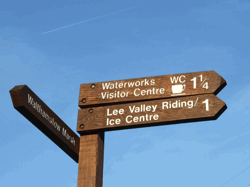 |
|
| Walthamstow Wetlands | |||||
|
| Walthamstow Wetlands
Overview | ||









|
Walthamstow Wetlands is a plan to open up the area around Walthamstow Reservoirs to the public.
The aims appear to be Θ to provide a north-south traffic-free cycling and walking route connecting Blackhorse Lane to Coppermill Lane. Θ to allow the public free access to this nature reserve and open land Θ to re-naturalise some areas. Money is to be spent on Θ landscaping and wilding some areas Θ providing a boardwalk through some parts Θ Providing two new visitor centres in two historic buildings. The Marine Engine House will become a visitor centre, while the tower of The Coppermill will be transformed into a viewing platform. The project was initiated by London Wildlife Trust, backed by Waltham Forest Council, with design work by KLA, a firm who describe themselves as landscape architects. (http://kland.co.uk/ ). Thames Water, who own the land have provided some funds. The project now has its own website: http://www.walthamstow-wetlands.org.uk/ Changes to the Coppermill The summer school organised by Walthamstow and District Photographic Society includes a session on the interesting historic buildings in the area. Walthamstow does not have many historic buildings, and the Coppermill is one of the most striking. For photographers, the area of interest is capturing interesting sky effects through the open arches. Through various incarnations since the first recording in 1066, the mill has used the power of the flowing Lea water to drive a variety of industrial processes. the Coppermill has been used to grind gunpowder, make paper, extract oil, and milling copper sheets. The East London Waterworks Company bought the mill in 1860, initially using the waterwheel to pump the water from the nearby reservoirs. In 1864, the waterwheel was replaced by a Cornish Bull Engine, and the Italianate tower built to house it. [Ref 7] More history at Engineering Timelines [Ref 7]. During the talk at the Open House open day, the architects seemed not overly impressed with our building. Something is wrong with the balance of the arches, and there were more such buildings further down the Lea. The plan to use the Coppermill as a viewing platform, involves installing a lift to provide access, and the plans show that the arches at one end of the tower will be filled in with brick to conceal the lift mechanism. The other arches will be filled with fine wire mesh (See page 89 of the Design Access Statement, ref 2) . The mill buildings have ever been changed and adapted to the changing needs of commerce. For the most part, the modifications are sympathetic to the industrial nature of the building. But in one area, the plans will really spoil the building, by bricking up two arches, and filling in the rest. Several people expressed this view to various representatives at the Open Day. Criticisms There are many beneficial features of this development. Here are some criticisms. Coppermill Bricking in two arches, and inserting mesh in the rest will spoil the façade. Few Access benefits The new entrances are planned to be Θ on Forest Road (where it crosses Coppermill Stream) Θ By the Coppermill, on Coppermill Lane, Θ Through the footpath near Lockwood Way on Blackhorse Lane. Apart from those who live in Higham Hill, folks from most of Waltham Forest will still have to walk all the way across the Lee Valley before being allowed in. Just as they have to on both Coppermill Lane and Forest Road. There has been little thought given to the possibility of routing long-distance walks through the area, e.g. by connecting with the Lee Navigation, or Tottenham Marshes at the North, or providing more entrances on the East side of the land. Supporting new Housing There can be few doubts that Waltham Forest will mirror Haringey by authorising the building of flats on the industrial area along the Lea side of Blackhorse Lane. However, there is insufficient green space and parks within Higham Hill for such housing. Hence the urgent need to open up the reservoirs with an access point in Higham Hill. Transport Some criticism has been made of the quantity of new car parking, [p 140, ref 5] Separating the people from the Nature A preferred path is being routed through the site, with branded grip rails, mesh infill, and signage. The result looks like a sort of board-walk, keeping the people firmly away from the nature, not even able to walk on the grass. This approach can be seen in other new parks (e.g. the new Olympic Park), where visitors can view the nature, but are kept firmly apart from it. This is a worrying trend in recent park developments. At the Open Day, it was established that access would not be restricted to this path. | |
| References
1 Stage D Design & Access Statement (May 2014), Part 1 (pages 1-40) https://www.walthamforest.gov.uk/Documents/Design%20-%20Access%20Statement%20Part1%20-%20Pages%201-40.pdf 2 Stage D Design & Access Statement (May 2014), Part 2 (pages 41-91), http://www.walthamforest.gov.uk/Documents/Design%20-%20Access%20Statement%20Part2%20-%20Pages%2041-91.pdf 3 Stage D Design & Access Statement (May 2014), Part 3 (pages 92-129), http://www.walthamforest.gov.uk/Documents/Design%20-%20Access%20Statement%20Part3%20-%20Page%2092-129.pdf 4 Stage D Design & Access Statement (May 2014), Part 4 (pages 130-151), http://www.walthamforest.gov.uk/Documents/Design-Access%20Statement%20Part4%20-%20Page%20130%20-%20151.pdf 5 Stage D Design & Access Statement (May 2014)Part 5 (pages 152-159), http://www.walthamforest.gov.uk/Documents/Design%20-Access%20Statement%20Part5%20-%20Page%20152%20-%20159.pdf 6 Open Day, 20/9/14 London Wildlife Trust hosted a visit as part of Open House. 7 http://www.engineering-timelines.com/scripts/engineeringItem.asp?id=1184. | ||
| MarshWalker | ||
